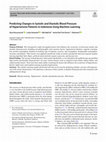Papers by desy Nuryunarsih
Current developments in nutrition, Jul 1, 2024
Global public health, May 16, 2024

medRxiv (Cold Spring Harbor Laboratory), Oct 1, 2023
Objective Smoking is very common in Indonesia: among adults, around 66% of males and 7% of female... more Objective Smoking is very common in Indonesia: among adults, around 66% of males and 7% of females are smokers. Smoking is not only harmful for people who smoke but also for people who are exposed to secondhand smoke on a regular basis. Previous research in various countries has shown a changing trend in smoking during the COVID-19 pandemic. However, despite the high prevalence of smoking in Indonesia and the shifting trend during COVID-19, no studies have utilized machine learning to investigate the potential increase in daily cigarette consumption during the pandemic. This study aimed to predict the increase in daily cigarette consumption among smokers during the pandemic, focused on smokers selected from vaccination registrants in the Special Region of Yogyakarta. Design Five machine learning algorithms were developed and tested to assess their performance: decision tree (DT), random forest (RF), logistic regression (LoR), k-nearest neighbors (KNN), and naive Bayes (NB). The results showed a significant difference in the number of cigarettes consumed daily before and during the pandemic (statistic=2.8, p=0.004). Setting This study is believed to be the first study prediction model to predict the increase of cigarette consumption during the COVID-19 pandemic in Indonesia. Results The study found that both DT and LoR algorithms were effective in predicting increased daily cigarette consumption during the COVID-19 pandemic. They outperformed the other three algorithms in terms of precision, recall, accuracy, F1-score, sensitivity, and AUC (area under the curve operating characteristic curve). LoR showed a precision of 92%, recall of 99%, accuracy of 93%, F1-score of 96%, sensitivity of 91% and AUC of 78%, DT showed a precision of 88%, recall of 91%, accuracy of 81%, F1-score of 89%, sensitivity of 95% and AUC of 98%. Conclusion We recommend using the DT and LoR algorithms, as they demonstrated better prediction performance. This study can be used as a pilot study for predicting smokers' continuing behaviour status and the possibility of smoking cessation promotion among smokers, this study is a short report, and we suggested expanding with more factors and a larger dataset to provide more informative and reliable results, The recommendations based on the current findings can serve as a starting point for initial actions and can be further validated and refined with larger-scale studies in the future. STRENGHTS AND LIMITATION OF THIS STUDY This is the first study to investigate the increased number of cigarettes consumed daily by Indonesian smokers during the pandemic using machine learning models. This paper using Multiple Algorithms: The author did not rely on a single algorithm but compared five different ML methods, providing a comprehensive analysis. This paper using external research as a reference, the author established a solid basis for their methodology and ensured their research was supported by existing literature. The paper clearly identified the DT model as superior, bringing clarity to the readers. The paper suggests that the developed framework has wide applicability in healthcare, increasing its relevance and potential impact. This paper considered only a few features (27), and more data on economic factors can be incorporated in future research work, as it will enable the real-life application of this model. The selection bias introduced by recruiting participants from those who came for vaccination. This sample may not fully represent the general population.

Current Hypertension Reports, Aug 28, 2023
Purpose of Review This retrospective study investigated factors that influence the occurrence of ... more Purpose of Review This retrospective study investigated factors that influence the occurrence of decreased systolic and diastolic blood pressure including sociodemographic and economic factors, hypertension duration, cigarette consumption, alcohol consumption, duration of smoking, type of cigarettes, exercise, salt consumption, sleeping pills consumption, insomnia, and diabetes. These factors were applied to predict the reality of systolic and diastolic decrease using the machine learning algorithm Naïve Bayes, artificial neural network, logistic regression, and decision tree. Recent Findings The increase in blood pressure, both systolic and diastolic, is very harmful to the health because uncontrolled high systolic and diastolic blood pressure can cause various diseases such as congestive heart failure, kidney failure, and cardiovascular disease. There have been many studies examining the factors that influence the occurrence of hypertension, but few studies have used machine learning to predict hypertension. Summary The machine learning models performed well and can be used for predicting whether a person with hypertension with certain characteristics will experience a decrease in their systolic or diastolic blood pressure after treatment with antihypertensive drugs.
The Lancet Regional Health - Europe, Dec 31, 2023

Nicotine & Tobacco Research, Jan 27, 2021
Introduction: The objective of this study is review the evidence on the health risks associated w... more Introduction: The objective of this study is review the evidence on the health risks associated with smoking kretek cigarettes compared with not smoking or smoking regular cigarettes. Methods: We conducted a systematic literature search in five electronic databases: EMBASE (Ovid), ASSIA, PubMed and Scopus. Since kretek use is largely restricted to Indonesia, we identified additional studies using an online search for grey literature and studies in Indonesian journals and the National Library of Indonesia. We included relevant search terms in English ("kretek" and "clove cigarettes") and Bahasa ("rokok" and "merokok"). We selected studies which compared any health outcome between smokers of kretek cigarettes and non-smokers or smokers of regular cigarettes. We included studies in any smokers compared to non-smokers in Indonesia, since most Indonesian smokers use kretek, but analysed these separately. Study data were extracted by a single reviewer and checked by two reviewers. Methodological quality was assessed using the Newcastle-Ottawa scale. Results: We identified 32 studies, all from Indonesia. There were 31 cross-sectional studies and one case control study. This systematic review identified a relatively limited number of studies, and most of these were of poor quality as assessed by the Newcastle Ottawa score. They were generally cross-sectional, small and lacking justification for sample size, had high potential for selection bias because of lack of data on non-respondents or those lost to follow up, and missing information about the statistical analysis. Fourteen studies looked specifically at kretek exposure and eighteen looked at any type of cigarette exposure but were conducted in Indonesia are therefore likely to predominantly reflect kretek exposure. Kretek were found to be associated with oral cancer, cardiovascular disease, chronic health disease, myocardial infarction, asthma, and oral diseases. Conclusions: Although existing studies are of poor quality, kretek are likely to be at least as harmful as regular cigarettes.

Environmental Analysis Health and Toxicology
Health professionals (HPs) can play an important role in influencing the smoking behavior of thei... more Health professionals (HPs) can play an important role in influencing the smoking behavior of their patients and the implementation of smoke-free workplace policies. In some countries physicians and dentists may not have a no-smoking policy in place. Breathing in other people’s tobacco smoke (second-hand smokers) increase the risk of smoking related diseases. Environmental Tobacco smoke ETS causes a similar range of diseases to active smoking, including various cancers, heart disease, stroke, and respiratory diseases. Little is known about the smoking-related attitudes and clinical practices of HPs in Indonesia. Evidence suggests that high smoking rates remain among male HPs; however, the risk perceptions and attitudes to smoking among Indonesian HPs have not been investigated using prediction model artificial neural networks. For this reason, we developed and validated an artificial neural network (ANN) to identify HPs with smoking behavior. The study population consisted of 240 HPs...
Access to and use of the material held within the University of Nottingham's Institutional Reposi... more Access to and use of the material held within the University of Nottingham's Institutional Repository (the Repository) is based on your acceptance of the following terms and conditions:

Herbal medicine is widely used in Indonesia. Thus, counterfeit herbal medicines are a great conce... more Herbal medicine is widely used in Indonesia. Thus, counterfeit herbal medicines are a great concern given the negative impact to individual and population health. This paper used data drawn from the National Agency of Drug and Food Control (NADFC/BPOM) of Indonesia to describe the counterfeit trend against registered herbal drugs from 2011 to 2014, and further analyses were performed to discover the types of the fraud, the impact to the health and conventional drugs that could be used as substitutes for herbal drugs. The research found that the amount of falsified medicines is increasing along with the increasing number of registered herbal drugs. From the data obtained, similar falsified herbal drugs were identified for both life style drugs (51%) and health-related condition drugs (49%). In addition, almost all falsified herbal drugs are adulterations plus tampering (81%). The most significant substitute chemical drug is paracetamol.

Nicotine & Tobacco Research
Introduction The objective of this study is review the evidence on the health risks associated wi... more Introduction The objective of this study is review the evidence on the health risks associated with smoking kretek cigarettes compared with not smoking or smoking regular cigarettes. Methods We conducted a systematic literature search in five electronic databases: EMBASE (Ovid), ASSIA, PubMed and Scopus. Since kretek use is largely restricted to Indonesia, we identified additional studies using an online search for grey literature and studies in Indonesian journals and the National Library of Indonesia. We included relevant search terms in English (“kretek” and “clove cigarettes”) and Bahasa (“rokok” and “merokok”). We selected studies which compared any health outcome between smokers of kretek cigarettes and non-smokers or smokers of regular cigarettes. We included studies in any smokers compared to non-smokers in Indonesia, since most Indonesian smokers use kretek, but analysed these separately. Study data were extracted by a single reviewer and checked by two reviewers. Methodolo...

Annals of Tropical Medicine and Public Health
Waste is the result of human activities that cannot be used anymore. Waste that is not managed pr... more Waste is the result of human activities that cannot be used anymore. Waste that is not managed properly can cause disease. The volume of waste in Bantul reached 2 190 t d-1 and experienced an increase in 2016 amounting to 2 299.29 t d-1. The Aims of this study to compare the method of demonstration of three-dimensional trash with conventional. Settings and Design of this study was a quasi-experimental design with a non equievalent control group. Methods and Material: as many as 30 respondents for each group. Data from the study were analyzed using the test Mann-Whitney with a confidence level of 95 %. The results of the study showed an increase in knowledge, attitudes and practices in the experimental group and there were differences in knowledge, practices between the experimental and control groups. Conclusions of the study, there are different demonstration methods using three trash bins with conventional trash cans to the meaningful knowledge and practice of sorting trash from the Al-Qur'an Mosque Education Park children, while those in attitudes are not meaningful. It is recommended that the management of the Al-Qur'an Mosque Education Park use a three-dimensional trash can as an intermediary so that the children of the Al-Qur'an Education Park get used to sorting and disposing of garbage in its place.

Kesmas: National Public Health Journal
Counterfeit medicines potentially reach 70% of the global drug markets, and the largest proportio... more Counterfeit medicines potentially reach 70% of the global drug markets, and the largest proportion is found in developing countries. Increasing public awareness of counterfeit medicines will automatically affect the demand for counterfeit medical products that will finally reduce counterfeit medicine activities. However, raising awareness of the dangers of counterfeit medicines is a challenging task because public health professionals need to consider diversity of social, economic and educational factors. This study examined peer-reviewed journal articles, media reports, official government and non-government reports. As many as 179 papers (1990 to 2014) were retrieved to identify the relationship between Human Development Index (HDI) of the USA, Japan, Brazil, Iran, Vietnam, Indonesia, Pakistan and Nigeria, and the type of counterfeit medicines. An electronic search was conducted using the following databases, such as Medline, Scopus, CINAHL, Embase, Google Scholar. Counterfeit dis...

Kesmas: Jurnal Kesehatan Masyarakat Nasional, 2015
Dengue hemorrhagic fever (DHF) is a leading cause of hospitalization and death among children. In... more Dengue hemorrhagic fever (DHF) is a leading cause of hospitalization and death among children. Indonesia is one of those countries categorized by World Health Organization (WHO) as hyperendemicity with four serotypes circulating in urban area. Sociodemographic factors are considered as factors affecting DHF in Indonesia. This study used secondary data downloaded from Province Health Database 2010 of Health Ministry Republic of Indonesia to determine correlation between three sociodemographic factors to DHF incidence. This study used quantitative descriptive correlational methods. Results showed the selected two sociodemographic factors had a linear impact on DHF incidence. Multiple regression multivariate analysis showed least correlation between DHF incidence and three selected sociodemographic factors. However, the univariate regression analysis showed that population density and poverty had significant correlation to DHF, respectively the population density r(4) = 0.843, p value ...











Uploads
Papers by desy Nuryunarsih